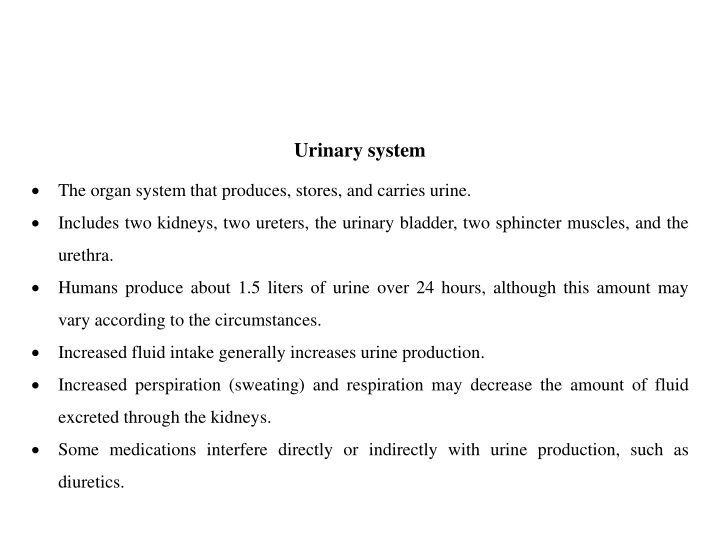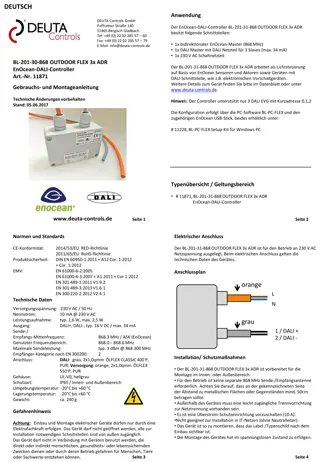
The Urinary System: Kidney Anatomy and Function
The urinary system consists of the kidneys, ureters, bladder, sphincter muscles, and urethra, working together to produce, store, and carry urine. The kidneys filter blood plasma, regulate electrolytes, balance fluids, and perform vital functions like regulating blood pressure and producing erythropoietin. Explore the structure and function of nephrons, the basic unit of the kidney responsible for filtering out waste and regulating water and soluble substances. Learn about the glomerular apparatus, proximal and distal tubules, loop of Henle, and collecting ducts that make up the intricate kidney anatomy.
Download Presentation

Please find below an Image/Link to download the presentation.
The content on the website is provided AS IS for your information and personal use only. It may not be sold, licensed, or shared on other websites without obtaining consent from the author. If you encounter any issues during the download, it is possible that the publisher has removed the file from their server.
You are allowed to download the files provided on this website for personal or commercial use, subject to the condition that they are used lawfully. All files are the property of their respective owners.
The content on the website is provided AS IS for your information and personal use only. It may not be sold, licensed, or shared on other websites without obtaining consent from the author.
E N D
Presentation Transcript
Urinary system The organ system that produces, stores, and carries urine. Includes two kidneys, two ureters, the urinary bladder, two sphincter muscles, and the urethra. Humans produce about 1.5 liters of urine over 24 hours, although this amount may vary according to the circumstances. Increased fluid intake generally increases urine production. Increased perspiration (sweating) and respiration may decrease the amount of fluid excreted through the kidneys. Some medications interfere directly or indirectly with urine production, such as diuretics.
Kidneys Morphology: o It is paired organ (weight about 300g) o The compound from two parts: cortex (isotonic urine) and medulla (hypertonic urine) Cortex: Glomerular apparatus Medulla: Divided: Outer and Inner. Consists of about 1 million filtering units termed nephrons (basic structural and functional units) The kidney plays a crucial role in regulating electrolytes in the human blood (e.g. Na+, K+, and Ca2+). It clears urea, a nitrogenous waste product from the metabolism of amino acids.
Kidney function Filters blood plasma, eliminates waste, returns useful chemicals to blood. Regulates blood volume and pressure. Regulates osmolarity of body fluids. Secretes renin, activates angiotensin, aldosterone. o controls blood pressure, electrolyte balance Secretes erythropoietin red blood cell production in the bone marrow. Regulates PCO2 and acid-base balance. Detoxifies free radicals and drugs.
Kidneys as filters Diuretic- loose water; coffee, alcohol. Antidiuretic- retain water; ADH. Aldosterone- sodium and water reabsorption, and K+ excretion. GFR= 180 liters of blood/day. 178-179 liters are reabsorbed back into the blood. Excrete a protein-free filtrate.
Nephron A nephron (1-1.2 million) is the basic structural and functional unit of the kidney. Its chief function is to regulate water and soluble substances by filtering the blood, reabsorbing what is needed, and excreting the rest as urine. Each nephron is composed of an initial filtering component (the renal corpuscle) and a tubule specialized for reabsorption and excretion (the renal tubule). The renal corpuscle filters out large solutes from the blood, delivering water and small solutes to the renal tubule for modification.
Parts Glomerular apparatus. Proximal tubule. Loop of Henle. Distal tubule. Collecting ducts Each kidney contains over 1 million nephrons and thousands of collecting ducts
Types of nephrons: Cortical nephrons (glomerular apparatus belong to the surface and Loop of Henle only to the outer part of the medulla). Juxtamedullary nephrons (glomerular apparatus deep in the cortex near the medulla and Loop of Henle is going deep to the inner part of the medulla).
Renal (Malpighian) corpuscle Malpighian capsule refers to the blood filtering component of the kidney. It is also called the renal corpuscle. The main function of the Malpighian capsule is the filtration of blood. The two components of the Malpighian capsule are the Bowman's capsule and the glomerulus. Glomerulus - is a capillary tuft that receives its blood supply from an afferent arteriole and passes into the efferent arteriole of the renal circulation. Efferent arterioles of juxtamedullary nephrons (ie, the 15% of nephrons closest to the medulla) send straight capillary branches that deliver isotonic blood to the renal medulla. Along with the loop of Henle, these vasa recta play a crucial role in the establishment of the nephron's countercurrent exchange system. Bowman's capsule - surrounds the glomerulus and is composed of visceral (inner) and parietal (outer) layers.
Figure: Glomerular filtrate collects in capsular space, flows into the renal tubule Figure: Glomerular filtrate collects in capsular space, flows into the renal tubule





















